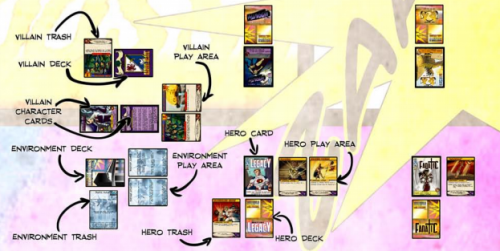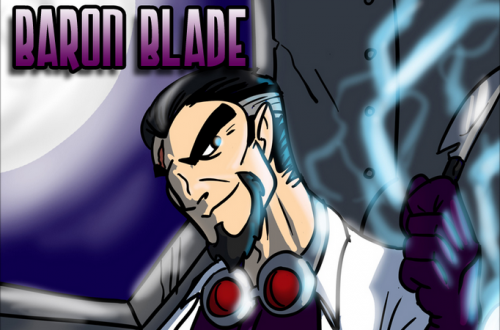
Before any heroes get to take a turn, though, the villain phase takes place. Sentinels of the Multiverse features several colorful villains, such as mad scientist Baron Blade and the Omnitron, a sentient robotics factory gone berserk. The villain turn consists of playing and resolving a new card from the villain deck. Like hero cards, these have various effects; minions might be summoned, weapons fired, or defenses raised. Each villain plays much differently than the others. Most operate in stages, similar to a video game boss. Baron Blood, for example, starts off in mad scientist mode, but if players defeat him before he crashes the moon into the earth (which happens if he ever gets 15 cards in his trash pile), he comes back in a huge suit of battle armor to exact his vengeance.
After the heroes all have a turn, the environment phase kicks in. There's a good variety of settings, ranging from easy Megalopolis, where the police might show up to assist the heroes, to the sunken city of Atlantis, where you are more likely to encounter a giant squid. Often, the game will hinge on these environmental effects, especially when something happens that damages the villain as well as the heroes. Once the villain, all players, and the environment phases have taken place, the process starts all over again.

On the surface, Sentinels of the Multiverse might seem like a very simplistic game. The rules themselves are very simple, but this is by design. The complexity in gameplay comes from the interactions of the cards. Combos can be played that are satisfying, and extremely effective, but at times the villain deck seems almost unbeatable. Cooperation between players is strong, and absolutely necessary; some heroes have the power to heal, buff, or redirect damage. You'll really feel like a super hero team working together to defeat your powerful foes. One flaw of the game is the difficulty in keeping track of all the effects, which can be a headache, even with a piece of paper. I'd have appreciated tokens of some sort, or hit point trackers, at the bare minimum. Another drawback is the box, which is all but useless once the cards are unpacked. A cheap card box is a workable though inelegant solution to this problem.
Just as in the Avengers or the Justice League, the various parts of Sentinels of the Multiverse work together to form a powerful union. The characters are interesting, the villains are suitably dastardly, and the overall feel is just like you are in a comic book. The game works well from between two and five players, in my experience, though with two players, each person should probably play as two heroes. Optional advanced difficulty levels, and the numerous combinations of heroes, villains, and environments ensure a high degree of replayability. The game is super (pardon the pun) friendly to young players, as well. I highly recommend Sentinels of the Multiverse to all co-op fans, but especially those who grow up wearing Batman or Wonder Woman Underoos.